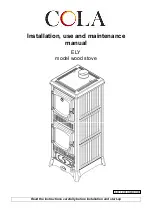
to avoid dangerous flash fires. Do not burn full loads of very small wood such as shavings
and splinters, as they produce excessive heat for short durations.
The fuel logs must not be stored in the immediate vicinity of the stove. Remember the safety
distances. Only bring into the sauna as much wood as you can fit immediately into the fire
compartment.
3.2. Adjusting the air flow
The heater has been designed to function best when the negative pressure of the flue is
approximately –17 Pa. If the chimney is long, this optimal negative pressure limit may be
exceeded. Adjust the draft and combustion air flow using a damper so that it is suitable. Be
careful of carbon monoxide. The damper must not be close too far!
When lighting the fire, the door may be kept slightly open for a moment. The ash pan can be
closed. It is not opened during burning. Combustion air comes from another source.
3.3. Adjusting the heat output
The batch's wood quantity determines the heating efficiency. Table (2) shows the correct
amounts of wood which guarantee burning in accordance with the CE marking.
The heat output is affected by the quality and amount of fuel. Do not burn excessively long
logs in the stove. Take care not to heat the stove constantly to a red glow.
3.4. Lighting
•
Place small logs into stove parallel to the grate. Amounts and total per table (2).
•
Add kindlings under the logs and light them.
•
You can keep the fire door open for a moment while logs start to burn.
You may also light from the top, but ithen burning will be slower.
3.5. Adding a batch
Add the actual heating batch when fire has nearly burned down to embers. Wood quantity
table (2)
Fill the stove parallel to grate with logs. Close the fire door.
Sauna is normally ready for bathing after 40 to 50 minutes, and it is not necessary to add
more wood for one sauna bath.
3.6. Continuing heating
Due to the amount of bathing, cold conditions etc., another load of wood may have to be used for
heating.
When the first load has burned down to embers, add more wood into the stove parallel to the grate.
Wood quantity to be added in table (2).
4. Maintenance
4.1. Cleaning the stove
The stove’s surface can be cleaned with a mild cleaning fluid detergent solution by wiping
down with a soft, moist rag.
The glass doors are cleaned with Kastor’s Noki Pois cleaning fluid, which is available in
hardware stores.
4.2. Ash removal
Excessive ash shortens the grate’s lifespan and weakens the burning. Remove the ash while
it is cold, always before the next heating, using a metal container to avoid a fire hazard.
.
Lift the front edge of the ash pan, so that it can be pulled out of the stove and emptied.
12
Summary of Contents for Karhu PK 007
Page 16: ...16...
Page 17: ...17...
Page 22: ...1 Savupeltilaite R kspj ll Chimney valve device 22...
Page 24: ...A 400 400 B 500 C 50 D 500 E 50 F 400 Kuva bild picture p 6 Kuva bild picture p 7 24...
Page 25: ...25...
Page 26: ...26...
Page 27: ...27...
Page 28: ...28...
Page 29: ...29...
Page 30: ...30...
Page 31: ...31...
Page 32: ...32...
Page 33: ...v 4 05 11 13 33...













































